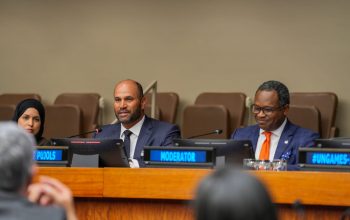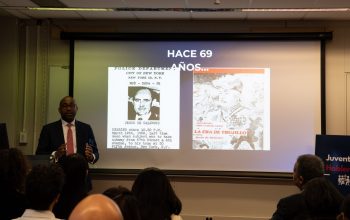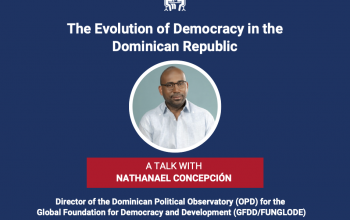news
“Vladimir Guerrero: de Don Gregorio a Cooperstown”, an article by Dr. Leonel Fernández
February 21, 2018
In the middle of the final leg of an intense and passionate competition, not suitable for those with cardiac conditions, between the Águilas Cibaeñas (the Cibao Eagles) and the Tigres del Licey (the Licey Tigers), all of sudden, the greatly anticipated news started to circulate: Vladimir Guerrero had been inducted into the Cooperstown Hall of Fame.
Upon hearing this information, the Dominican people burst with joy. Excitement was everywhere. His return to
the country was awaited with great expectation. For a moment, even the rivalry between the two teams seemed to dissipate. There was a kind of ceasefire in recognition of the ultimate symbol of national pride.
His arrival was quite an event. In a humble gesture, which is so typical of him, he highlighted that his achievement had no other purpose than to reflect positively on the Dominican Republic.
The music, the passion, the excitement awaited him at
the Las Americas International Airport. It continued all the way to the city. It was felt in the capital’s Malecón and stretched to the very heart of his hometown, Don Gregorio, Nizao, in the Peravia province.
The Dominican people really enjoyed to the fullest Vladimir Guerrero’s, one of our greatest baseball stars of all time, induction to the exclusive cluster of the immortals of that sport.
It was just three years ago, in 2015,
that Pedro Martínez, better known as Pedro the Great, a teammate at the Montreal Expos, was selected as the second Dominican player to be inducted into the Cooperstown Hall of Fame.
However, for 32 years since his selection in 1983, Juan Marichal, the Monster of Laguna Verde, reigned by himself in that special category, which is reserved for the most exceptional baseball athletes. Interestingly, the Monte Cristi native ended his professional career in 1975, the same year
that Vladimir Guerrero, the Storm of Don Gregorio, as sportswriter Bienvenido Rojas affectionately named him, was born.
But, a greater coincidence is that Vladimir always wore number 27 in the uniforms of the four teams for which he skillfully played; Marichal wore the same number when he played for the San Francisco Giants.
Humble Origins
Born in the midst of the Cold War in a country where leftist ideas
prevailed, it seems understandable that his parents had given his son, the future star of the Major Leagues, the name of the legendary leader of the Bolshevik Revolution: Vladimir, known as Lenin.
But then again, at present, Russia’s President Putin also bears the same name: Vladimir.
In the field of sports, Vladimir Guerrero is not beneath his Russian namesakes. He also ruled at the diamond, due to the power of his bat, the speed of his legs
and the strength of his arm.
Vladimir Guerrero, however, was born in a very humble peasant household. His mother sold food on the street and his father made a living working with cattle in a small rented farm.
Along with his seven brothers, he lived in extremely cramped and precarious conditions in a two-room house made of wood and with a tin roof, which in the 90s was knocked out by a hurricane.
But, together with Eliezer and
Winston, his two older brothers, he found his life””s passion at a young age: baseball. He began to practice the sport at the age of 11, in the same community that has seen other great players such as Miguel Tejada, the forever remembered shortstop of the Oakland Athletics and the Baltimore Orioles.
In the beginning, Eliezer was considered for training with the Los Angeles Dodgers team. A short time later, however, he was set aside. His other brother Winston, by
contrast, was signed by the same team, for which he ended up playing in the Major Leagues.
Vladimir was also noticed by the same sports team. Luck, however, was not with him. At the beginning of his training he was injured, which was the reason why he abandoned his dreams of wearing Jackie Robinson””s team shirt.
That injury could have been the end of the Nizao native””s sports career. But his discipline, willingness to sacrifice and his
perseverance, allowed him to overcome this and other difficulties; and thus, in 1996, at the age of 21, he began his professional Major League career with the Montreal Expos.
With the Expos, Guerrero had the good fortune of finding at the helm of the team one of the stars of Dominican baseball: Felipe Rojas Alou. For the next six years, under Rojas Alou’s guidance, he established himself as a great average and powerful hitter.
The
Immortal Banilejo
In 2002, Vladimir went on to wear the uniform of the Los Angeles Angels, a team based in Anaheim, CA, in which he played for eight years, and then finished his career playing with the Texas Rangers and the Baltimore Orioles.
During his years playing in the Major Leagues, he began to weave a myth: that, unlike the majority of the other players, he did not use mitts to hit and that he was a bad ball hitter.
We are
also reminded that, on one occasion, he swung a ball that went on a tailspin before reaching the plate, thus, he swung a hit. His arm, when playing right field, was superb. Nobody dared to challenge him by stealing the bases. Any attempt was almost certain to end up in an out.
In 2004, the year in which his team, the Los Angeles Angels, won the championship, he was awarded the title of Most Valuable Player of the American League. As a result of this recognition, he paid a
visit, together with his parents, to the National Palace, where I was honored to host him and to convey, on behalf of the government, our well-deserved congratulations.
Curious about the reasons that motivated him to chase the balls that went out of the strike zone, I remember asking him the following question: "How is it Vladimir that you can hit any kind of pitch? Is there a special technique for that?"
His answer was: "When
I was a child I used to play stickball (vitilla) in the street with the boys. I became an expert at hitting the vitilla, which, in addition to being small in size, has a zigzagging trajectory. So, because I had learned to hit the vitillas, the baseballs were easier for me."
His discipline at the batting box, his focus and perseverance in achieving each time more and better results, led him to finish his 16-year career in the Major Leagues with a lifetime batting
percentage of .318. This achievement, of course, placed him among the seven greatest players in the history of the sport. Likewise, he connected 2,590 hits, including 477 doubles. He hit 449 home runs. He run batted in 1,496 races, and scored 1,328 times. He won eight silver bats. Nine times he participated in the All-Star Game. In 12 of his sport’s seasons, he hit 20 or more home runs. In eight of them, he finished with an above .300 batting average; and the only two times when
he did not reach those percentages, he scored .290 and .295.
Vladimir Guerrero, the Cooperstown””s immortal Banilejo, is one of only two players in Major League history, along with Joe Dimaggio, to achieve three consecutive seasons with a .300 batting average; 30 home runs; 100 run batted ins; 100 annotated; and, a slugging percentage (how many hits a player has in relation to his times at bat) of 500, before he turned 25. In addition, he is among the only five players
in baseball history who have managed to connect hits in 30 consecutive games. Something that is simply spectacular.
Having reached the peak of his career and having been inducted in the select group of members of the Cooperstown Hall of Fame, Vladimir Guerrero, like Juan Marichal and Pedro Martínez, has become a source of pride, an icon, and an emblematic figure of the Dominican people that transcends the global scope.
Nowadays there are others who are
waiting to also join the immortals of baseball. Among them, of course, David Ortíz, the Big Papi, the man who ended the curse of the Bambino and took the Red Sox to more than one world championship; Albert Pujols; Adrián Beltré; Robinson Canó; and Nelson Cruz. Perhaps one day we will be able to see Vladimir Guerrero Jr., a talented young man, playing third base at the Toronto Blue Jays, reach the pinnacle of fame, following in his father’s footsteps.






